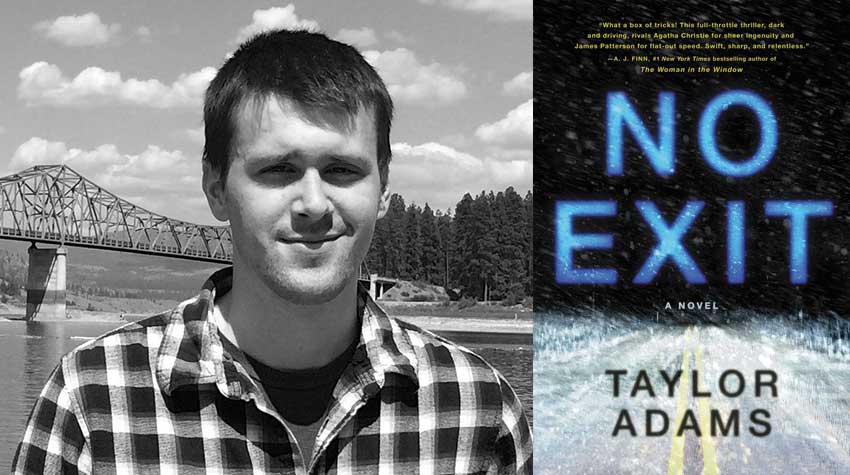Make It Thrilling: Taylor Adams on Adding Violence to Fiction
By Taylor Adams
January 23, 2019Taylor Adams, author of No Exit, breaks down how he infused his novel with violence and advises us how to not overdo it.

Storytelling is all about conflict, and conflict, in its purest form, is violence. That doesn’t mean violence is necessary in a thriller – far from it! – but it is a powerful item in any fiction writer’s toolbox, regardless of genre. That said… with pitfalls abound, it’s frighteningly easy to misuse.
Here is the general philosophy I used to effectively (and, hopefully, responsibly) incorporate violence into my psychological thriller novel No Exit.
MAKE IT SCARY
As readers, we can be a bit jaded. Can you blame us? We’ve read scores of stories featuring countless dead bodies – but actually witnessing a dead body in real life would be profoundly distressing. In fiction, our characters must be accordingly shocked – because to them, it is real – and I believe this can create a problematic distance between the reader and the hero (a shocked hero vs. an unimpressed reader). So, my solution is to try and shock them both! At certain points in No Exit, I really push the sensory descriptors – and even the gore – with the explicit goal of putting the reader and heroine Darby in the same emotional spot: extreme terror.
MAKE IT QUICK
You’ve heard this before – the unseen is many times scarier than the actual event – and not only is that true at least 90% of the time, but it’s also often better for the story’s pace. There’s a real horror to how swiftly a human life can end, and the surest way to drain that horror is to spend two full pages describing a stabbing. There are several beats in No Exit that I’d originally written out as full sequences, before realizing it was more effective to cut them short, or merely describe the aftermath. It’s best to give readers space to use their own potent imaginations while freeing your narrative to barrel on to the next new shock. And the next. And the next…
MAKE IT COUNT
A quick aside to cinema – perhaps I’m alone here, but I’ve always thought it a little strange how dozens of side characters can be mowed down by PG-13 gunfire with no visible spurt of blood. I feel this is a weirdly numbing approach to presenting violence, and by sanitizing the damage, ultimately it has the effect of cheapening life. If a whole roomful of “good guys” are massacred bloodlessly with little impact to the hero’s struggle, what were they really worth? A single lost life should feel like a tragedy, and minimizing a story’s body count helps make the bodies actually… count. And when you do kill a character – be honest about it, and show some blood!
MAKE IT WEIRD
A coworker of mine once told me a horrifying story about an incident he witnessed while out walking in downtown Seattle – and the part of the story that lingers in my mind the most is an odd detail, involving the behavior of a trickle of blood. When imagining outlandish events that most of us will never have the misfortune of witnessing in reality, I think it’s crucial to find and double down on the little details. The stranger, the better. Life is messy and unpredictable, and violence is often depicted in a cliché way, how we “expect” it to be based on books and movies we’ve already seen. Sometimes a jolt of the authentically absurd – a phone that won’t stop ringing, an elevator door that misbehaves – can be the little detail that grounds an entire scene, and makes it feel real.
ABOVE ALL, MAKE IT MEANINGFUL
No Exit’s final third is quite intense, and deliberately so. The graphic scenes are the purest distillation of lines of conflict that have been developing throughout the entire story. During a single harrowing night at a snowed-in rest stop, a young woman chooses to take responsibility for a child’s life, and as the consequences of this decision come into focus, our increasingly desperate heroine must fight hard and dirty to accomplish her mission. If I were to lessen or blunt the ensuing mayhem, the twin payoffs of Darby’s character growth and the villain’s ultimate ferocity would be blunted as well. That’s my main litmus test when deciding when and where I should include violence (or any major action): it should either escalate or resolve the dramatic questions that fuel the story.
Praised as “swift, sharp, and relentless” by #1 New York Times bestselling author AJ Finn, my suspense novel No Exit is on sale now. I hope you’ll check it out!
Comments are closed.

No Exit – Yes!